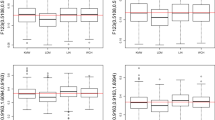Abstract
Recurrent event data arise in many biomedical and engineering studies when failure events can occur repeatedly over time for each study subject. In this article, we are interested in nonparametric estimation of the hazard function for gap time. A penalized likelihood model is proposed to estimate the hazard as a function of both gap time and covariate. Method for smoothing parameter selection is developed from subject-wise cross-validation. Confidence intervals for the hazard function are derived using the Bayes model of the penalized likelihood. An eigenvalue analysis establishes the asymptotic convergence rates of the relevant estimates. Empirical studies are performed to evaluate various aspects of the method. The proposed technique is demonstrated through an application to the well-known bladder tumor cancer data.
Similar content being viewed by others
References
Aalen OO (1988) Heterogeneity in survival analysis. Stat Med 7: 1121–1137
Aalen O, Husebye E (1991) Statistical analysis of repeated events forming renewal processes. Stat Med 10: 1227–1240
Aronszajn N (1950) Theory of reproducing kernels. Trans Am Math Soc 68: 337–404
Byar DP (1980) The Veterans Administration study of chemoprophylaxis for recurrent stage I bladder tumors: comparisons of placebo pyridoxine, and topical thiotepa. In: Pavone-Macaluso M, Smith PH, Edsmyn F (eds) Bladder tumors and other topics in urological oncology. Plenum, New York, pp 363–370
Du P, Gu C (2006) Penalized likelihood hazard estimation: efficient approximation and Bayesian confidence intervals. Stat Probab Lett 76: 244–254
Gail MH, Santner TJ, Brown CC (1980) An analysis of comparative carcinogenisis experiments based on multiple times to tumor. Biometrics 36: 255–266
Gill RD (1980) Nonparametric estimation based on censored observations of a Marcov renewal process. Zeitschrift für Wahrscheinlichkeitstheorie und Verwandte Gebiete 53: 97–116
Gu C (1996) Penalized likelihood hazard estimation: a general procedure. Stat Sin 6: 861–876
Gu C (2002) Smoothing spline ANOVA models. Springer, New York
Gu C (2004) Model diagnostics for smoothing spline ANOVA models. Can J Stat 32: 347–358
Gu C, Ma P (2005a) Generalized nonparametric mixed-effect models. J Comput Graph Stat 14: 485–504
Gu C, Ma P (2005b) Optimal smoothing in nonparametric mixed-effect models. Ann Stat 33: 1357–1379
Hougaard P (2000) Analysis of multivariate survival data. Springer, New York
Joly P, Commenges D, Letenneur L (1998) A penalized likelihood approach for arbitrarily censored and truncated data: application to age-specific incidence of dementia. Biometrics 54: 185–194
Kalbfleisch JD, Prentice RL (2002) The statistical analysis of failure time data. Wiley, New York
Karcher P, Wang Y (2001) Generalized nonparametric mixed effects models. J Comput Graph Stat 10: 641–655
Lin DY, Sun W, Ying Z (1999) Nonparametric estimation of the gap time distribution for serial events with censored data. Biometrika 86: 59–70
Nychka D (1988) Bayesian confidence intervals for smoothing splines. J Am Stat Assoc 83: 1134–1143
O’Sullivan F (1988a) Fast computation of fully automated log-density and log-hazard estimators. SIAM J Sci Stat Comput 9: 363–379
O’Sullivan F (1988b) Nonparametric estimation of relative risk using splines and cross-validation. SIAM J Sci Stat Comput 9: 531–542
Peña E, Strawderman R, Hollander M (2001) Nonparametric estimation with recurrent event data. J Am Stat Assoc 96: 1299–1315
Rondeau V, Mathoulin-Pellissier S, Jacqmin-gadda H, Brouste V, Soubeyran P (2007) Joint frailty models for recurring events and death using maximum penalized likelihood estimation: application on cancer events. Biostatistics 8(4): 708–721
Strawderman RL (2005) The accelerated gap times model. Biometrika 92: 647–666
Vaupel JW, Manton KG, Stallard E (1979) The impact of heterogeneity in individual frailty on the dynamics of mortality. Demography 16: 439–454
Wahba G (1983) Bayesian “confidence intervals” for the cross-validated smoothing spline. J R Stat Soc [Ser B] 45: 133–150
Wahba G (1990) Spline models for observational data, volume 59 of CBMS-NSF regional conference series in applied mathematics. SIAM, Philadelphia
Wang Y (1998) Mixed-effects smoothing spline ANOVA. J R Stat Soc [Ser B] 60: 159–174
Wang M-C, Chang S-H (1999) Nonparametric estimation of a recurrent survival function. J Am Stat Assoc 94: 146–153
Wei LJ, Lin DY, Weissfeld L (1989) Regression analysis of multivariate incomplete failure time data by modeling marginal distributions. J Am Stat Assoc 84: 1065–1073
Weinberger HF (1974) Variational methods for eigenvalue approximation, volume 15 of CBMS-NSF regional conference series in applied mathematics. SIAM, Philadelphia
Zeng D, Lin DY (2007) Maximum likelihood estimation in semiparametric regression models with censored data (with discussion). J Roy Stat Soc [Ser B] 69: 507–564
Zucker DM, Karr AF (1990) Nonparametric survival analysis with time-dependent covariate effects: a penalized partial likelihood approach. Ann Stat 18: 329–353
Author information
Authors and Affiliations
Corresponding author
Rights and permissions
About this article
Cite this article
Du, P. Nonparametric modeling of the gap time in recurrent event data. Lifetime Data Anal 15, 256–277 (2009). https://doi.org/10.1007/s10985-008-9110-4
Received:
Accepted:
Published:
Issue Date:
DOI: https://doi.org/10.1007/s10985-008-9110-4



